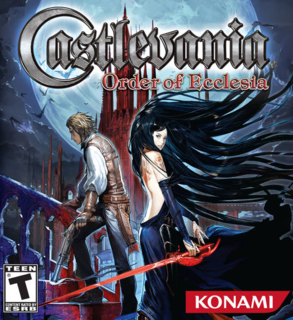It comes close to the pinnacle of the series, but falls short thanks to some irksome design issues.
The Order of Ecclesia is an organization with the intent of stopping Dracula from destroying the world. Barlowe, an aged priest, intends to give Shanoa special 'Dominus' powers in order to give her the power to eliminate Dracula; these powers are actually those of Dracula himself. The third member of the group, Albus, is consumed wih jealousy and feels betrayed. He interferes with the ritual and receives the powers instead of Shanoa. Shanoa loses her memories and identity, but is sent off by Barlowe to stop Albus from whatever evil he is doing. As expected in a Castlevania game, there are multiple endings here, the first of which meant to displease, while the final one is good. The story here is no masterpiece, but it sets the stage for wicked enemies, intense boss fights and goth-esque large environments. The change of personality is also a very good turn from previous DS titles; for example, Shanoa is the exact opposite of Portrait of Ruin's Johnathon -- attractive, serious and cold, befitting the series more than Johnathon's light-hearted, typical anime personality. The script is the strongest in the series, with some interesting characters and voice acting, and strays outside of the all-too-familiar Belmont comfort zone; having a female protagonist is the most interesting change to the writing here, and it works. Enemy taunts can at times be specifically aimed at Shanoa's gender, which can be funny at times and sets the overall mood to the game very well.
That said, the real experience is in the action. The new Glyph system is outstanding; as opposed to collecting weapons, Shanoa collects Glyphs. Every attack costs a small amount of mana, which replenishes itself very quickly when Shanoa isn't in action. These Glyphs are immensely superior to collecting weapons; it gives Iga and his team more creativity with how weapons look (wolves and golem fists could only be done here) and special weapons can be pretty cool (metamorphosing and summoning work much better than in previous games). Two Glyphs can be equipped at the same time; rapidly switching from one to the other creates a rapid attack that could not have been done with previous Castlevania control schemes. Hearts are now their own bar; using a Super Move, which can be used by combining two Glyphs that work together, uses up a certain amount of hearts. Everything in the game is perfectly balanced and its a ton of fun to develop techniques and strategies against enemies; as with any Castlevania, Order of Ecclesia's battle system is a well oiled machine that can hold its own against any other 2D platformer out there.
Another aspect of Order of Ecclesia that distinguishes it from other Castlevanias is its fetch quests; once you save villagers that Albus kidnapped, they give you requests to retrieve items or take pictures of areas. The rewards are solid enough to motivate the player to keep coming back and completing them. This system also makes the shop larger with more variety, but the player has to work to achieve this status; for example, healing items are extremely scarce until the player completes the Chef's requests.
A more convenient level system has effectively eliminated backtracking; players select what level to go to from a world map now. No longer are the days of aimlessly wandering around the castle looking for what to do. But if this sounds too good to be true, it isn't; amidst these accomplishments, Order of Ecclesia fails in repeated level design. In more than one case does a level have the same design as another, which is just disappointing and inexcusable for a game on a system full of great 2D platformers. Another disappointment may be the extremely linear design, which is an unfortunate turn for the series, but perhaps an unavoidable one given that it destroys backtracking.
Order of Eclessia boasts some very impressive boss fights that are the pinnacle of the series; but this part of the game is also what may be a deal breaker for casual gamers. Many of these boss fights are extremely tough and memorizing patterns may take a couple of deaths before the player gets the hang of it. But what these fights lose in harsh difficulty, they gain in brutality and intensity; not only are a few of the death sequences very memorable, these battles are as fast-paced as, say, Contra 4, if not as tough.
The title does not disappoint in its Presentation, either; the 2D work here is simply incredible and surpasses The World Ends With You and previous Castlevanias, making in the best looking 2D game on the platform. The art style has returned to a grim and dark look; enemy designs are appropriately morbid and visceral, and environments show off the art style like no other Castlevania before. The soundtrack is some of the best in the series and on DS, and a headphones option is available. Sound effects and enemy taunts sound great; combine all of this and you will find Order of Ecclesia has a personality completely different from its DS predecessors.
While Order of Ecclesia disappoints in extreme linear-ness and occasional cut and paste level design, the final product is far too great to be deemed anything less than one of the best tites on DS and easily in the ring of top 3 platformers for the system. It does things differently than many other Castlevanias and other things the same; the final product is a title worthy to be included in any hardcore DS owners' library.

